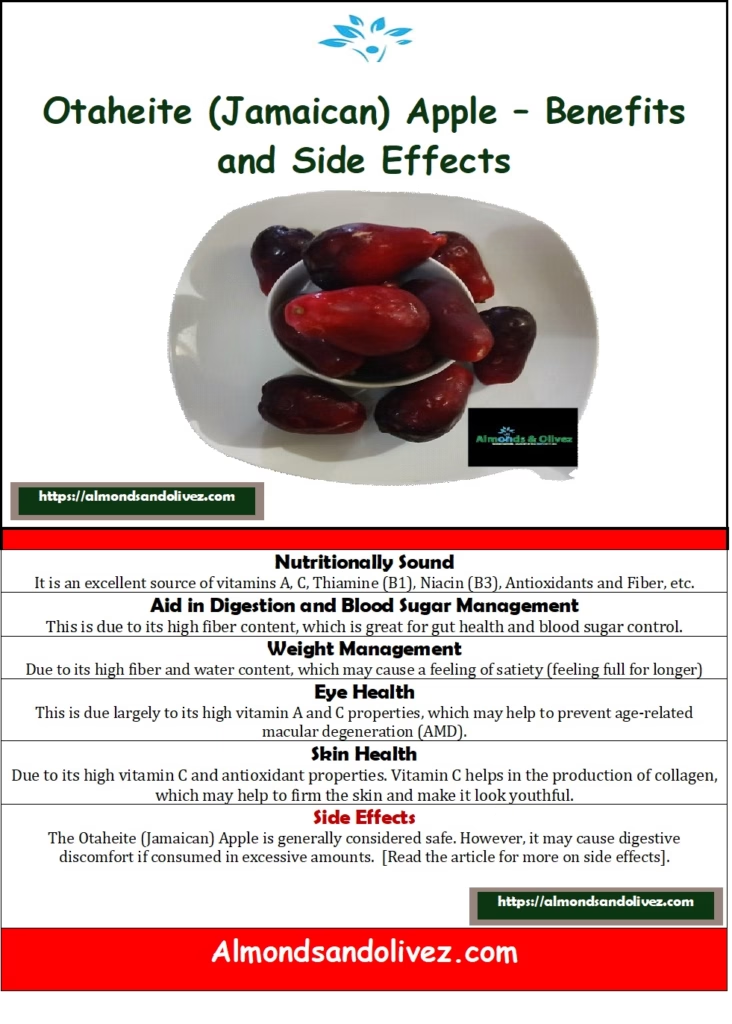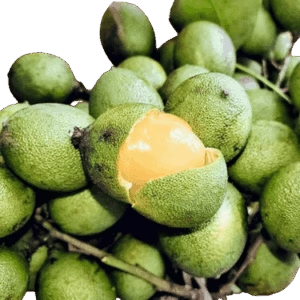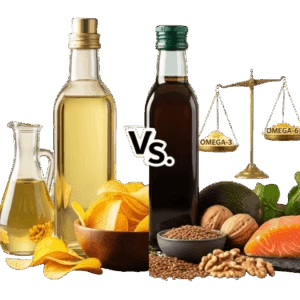TABLE OF CONTENTS
The Otaheite Apple, Malay Apple or what is better known in Jamaica as the Jamaican Apple, is one of my favourite fruits. I like this apple, especially when you get a sweet, sweet one, O Lord, you are in heaven (fruit heaven that is 😊). In Jamaica, you often see these apples being sold in the markets, on the streets, especially at stoplights, by vendors when they are in season.
But have you ever wondered about the nutrients of this fruit? What about its health benefits? Well, in this article, we’ll explore this little juicy fruit, from its nutrients to how to store and enjoy it. Let’s Discuss!
The Discussion
The Otaheite (Jamaican) Apple is a popular fruit in Jamaica, which can be found from May to September, with May to June being denoted mostly as the flowering months, August to September and in some countries, even up to November, denoted as the ripened months. But you can sometimes get this apple in January or earlier months before its noted ripened period.
Other common names for this fruit are the Malay Rose Apple, Malay Apple, Water Apple, and Mountain Apple, depending on the region. It is also known as Pommerac, which translates to ‘Malayan apple’ in French. However, scientifically it is known as Syzygium malaccense (L).
The Otaheite (Jamaican) Apple belongs to the Myrtaceae family (or the myrtle family), which includes some common fruits such as guava, strawberries and cherries, among others (Sciencedirect.com).
While many Jamaicans consider it ‘our apple,’ the Otaheite apple or Malay Apple reportedly originates from Malaysia and was adopted in many other countries with tropical or subtropical climates. As such, it only grows in climates of this nature and would not thrive in freezing temperatures.
The history of how it became part of the Jamaican landscape was due to it being taken here in 1793 by an English Officer, Captain William Bligh. Captain Bligh was part of the Royal Navy at the time and took the apples back from Tahiti after one of its voyages.
Hence the name ‘Otaheite’, which reportedly was the prior name given to the country of ‘Tahiti.’ You will also find these apples in India, Australia, Brazil, Indonesia, Thailand and Vietnam (Hargreaves and Hargreaves, 1964).
The Otaheite apple tree can grow between 5 – 18 meters or up to fifty-nine (59) feet tall, with its leaves being oval-shaped, thick and glossy. The apples are round or slightly pear-shaped with a red or pinkish hue. The fruit has a large inedible brown core, or what is called the ‘seed.’ You usually do not find the apples on branches with one single fruit, but rather in clusters of ripened fruits.
Due to its seasonality and short shelf life, it is usually not cultivated for general exports in many parts of the world (Kolhe Rohini et al. 2020). However, the apples have garnered interest from Scientists over the years due to purported medicinal and nutritional contents (Arumugam et al. 2014).
The Otaheite (Jamaican) Apple contains many nutrients, from amino acids to vitamins C and A, even fiber (Reynertson, 2008). It is reportedly used traditionally for treating sore throats, constipation, coughs and even diabetes (Reynertson, 2008). It may also have a positive effect on blood pressure, especially its barks, seeds and leaves (Morton, 1987; Reynertson, 2008).
In this article, we will explore its nutritional profile and note its health benefits. These include its high vitamin A and C contents as well as its high calcium and other minerals. There are also trace amounts of protein with a high fiber content.
The fruit may reportedly help with digestion and regulating blood sugar levels, weight management, eye and skin health. The article will also explore side effects, storage methods and ways to enjoy it.
5 Amazing Health Benefits of the Otaheite Apple
- A Nutritional Powerhouse.
- Aid in Digestion and Blood Sugar Management.
- May help with Weight Management
- May help with Eye health.
- May help with Skin Health.
Nutritional Powerhouse – Otaheite Apple
The Otaheite (Jamaican) Apple reportedly packs some important nutrients, such as vitamins, minerals, fiber, protein and antioxidants. Our body needs nutrients in general to help with energy production, proper functioning of bodily processes and overall growth and development. Without nutrients, our bodies would not thrive. Here are a few of the nutrients of the Otaheite (Jamaican) Apple.
- Vitamin A (in the form of beta-carotene): Vitamin A performs many crucial functions in the body. These include maintenance of the immune system, eye health, as well as overall growth and development.
- Vitamin B1 – Thiamin – is essential for converting carbohydrate nutrients into energy so that the body can utilize it. It is also vital for heart and muscle health, as well as for the proper functioning of the nervous system.
- Vitamin B2 – Riboflavin – is responsible for converting carbohydrates into energy. It is also essential for maintaining healthy skin, hair and the brain as well as producing red blood cells.
- Vitamin B3 – Niacin – works with Thiamin (B1) and Riboflavin (B2) to turn carbohydrate nutrients into energy to provide fuel for the body. Niacin also helps to maintain healthy skin and brain, and is important for nerve function.
- Vitamin C – is essential for the growth, repair and development of the body’s tissues. It is also critical for the formation of collagen, hence its widespread use in many cosmetic products geared at keeping wrinkles at bay. Vitamin C is also considered an antioxidant, which can strengthen the body’s resistance to infections as well as help the body absorb the mineral – Iron.
- Antioxidants – help to prevent damage to cells that is caused by free radicals. As such, the more antioxidant-rich foods we consume, the better it will be for our bodies to neutralize free radicals and prevent them from causing harm.
- Phytochemicals – It is abundant in phytochemicals such as polyphenols, especially anthocyanins, polysaccharides and organic acids (Sonawane, 2018).
- Fiber – is crucial for digestive health, promoting regularity and feeding beneficial gut bacteria.
- Protein – provides a trace amount of protein (less than 1 gram).
Otaheite (Jamaican) Apples also contain several minerals. Minerals, like vitamins, help the body to fulfil vital functions such as the building of strong bones and teeth, boosting the immune system, strengthening the nervous system, as well as contributing to the overall proper functioning of the body in general. The Otaheite (Jamaican) Apple reportedly comprise a few key minerals, such as:
- Calcium – which is crucial for the building of bones and teeth, regulates blood pressure as well as cholesterol levels. It also helps to keep the heart healthy and ensures healthy alkaline PH levels.
- Iron – is critical for the formation of red blood cells and the transportation of oxygen in the body. It also regulates growth and supports the immune system.
- Phosphorus – helps to get rid of bodily waste, repair tissues, helps in the proper functioning of the kidneys, and helps the body to utilize carbohydrates and fats.
You can read more about vitamins and minerals in these articles (with references):
Otaheite Apple for Digestion and Blood Sugar Management
A major stand-out nutritional benefit of the Otaheite (Jamaican) Apple is its high fiber content, which is crucial for a healthy digestive system and plays a vital role in maintaining gut health. It also helps to lower cholesterol (Kendall & Jenkins, 2004).
Fiber helps with regular bowel movement and thus reduces the risk of constipation, which is a common digestive issue. It also helps to keep the intestines clean. Additionally, the soluble fiber in Otaheite apple may also help to regulate blood sugar levels as well as serve as a prebiotic (Ngoc et al. 2008).
As such, it provides the necessary nourishment for beneficial bacteria in your gut microbiome. When our gut microbiome thrives, our digestive system remains healthy as it can properly absorb the nutrients from our diet and even helps to bolster the immune system.
In essence, incorporating Otaheite (Jamaican) Apples into your diet can significantly contribute to a happy and healthy digestive system, ensuring regularity, nourishing your gut, and helping you feel good from the inside out.
Here are some articles on other foods with high fiber content:
Otaheite Apple and Weight Management
Otaheite (Jamaican) Apple weight loss benefits are also due to its high fiber content. A high fiber diet also contributes to a feeling of satiety (feeling full). As such, consuming fruits like the Otaheite (Jamaican) Apple, especially if on a weight loss journey, may help to make you feel satisfied for longer, which can be beneficial for managing appetite and thus support your weight loss efforts.
Otaheite Apple for Vision and Eye Health
Otaheite (Jamaican) Apple is a great source for vitamin A (Beta-Carotene) and Vitamin C. Vitamin A (Beta-Carotene) is essential for good vision, especially in areas with low-lit conditions. Otaheite (Jamaican) Apple contains beta-carotene, which the body converts into vitamin A. Adequate vitamin A intake is crucial for maintaining the integrity of the cornea and preventing eye health issues, especially night blindness (American Academy of Ophthalmology).
In addition to its high vitamin A content, the Otaheite (Jamaican) Apple is high in vitamin C and other antioxidant compounds. Vitamin C acts as a powerful antioxidant, which helps to protect the eyes from damage caused by free radicals (Taylor et al. 1991). As such, adequate consumption may contribute to the prevention of age-related macular degeneration (AMD) and cataracts (Tanvetyanon and Bepler,2008).
Therefore, the regular consumption of fruits rich in vitamin C may contribute to long-term eye health as well as help prevent oxidative stress and support the integrity of the ocular tissues.
You can read more about eye health and other foods which can help to maintain it in this article:
Otaheite Apple and Skin Health
Due to its high vitamin C and antioxidant properties, Otaheite (Jamaican) Apple may help to boost your skin health, naturally. Vitamin C, in general, helps in the production of collagen, which is the most abundant protein in the skin (Merriam-webster.com).
Collagen helps to provide structural support, elasticity and firmness to the skin, which then helps to keep it looking plump and youthful. Additionally, collagen may also help with the appearance of wrinkles and fine lines (Traikovich, 1999).
Additionally, due to its high antioxidant compounds, the Otaheite (Jamaican) Apple may also help to neutralize free radicals caused by environmental stressors such as pollution and the dreaded UV radiation (Darr et al. 1992). As such, an adequate amount of vitamin C may help to prevent premature aging, reduce hyperpigmentation and help to even skin tone (Cosgrove, et al. 2007; Purba and Kouris-Blazos, 2001).
Another wonderful attribute of the Otaheite (Jamaican) Apple is its high-water content, which can serve to hydrate the skin. Proper hydration is key to maintaining the skin’s barrier function as well as retaining moisture.
Further, the nutrients in the Otaheite (Jamaican) Apple may also help to repair skin and support its natural healing processes. As such, incorporating this fruit in your diet is not only about enjoying it as a tropical fruit but also as a means to nourish your body and promote healthy, radiant skin.
You can read more about the skin and ingredients that can help with maintaining its glow and anti-aging in these articles:
How to Eat or Enjoy Otaheite Apple
There are many ways you can enjoy your Otaheite (Jamaican) Apples. The apples can simply be eaten raw (as is), after proper cleansing. Eating them raw is the case for many people around the world, and of course, in Jamaica. However, it can be juiced, which is a favourite of mine, especially when I have a lot of the fruits and I just do not want them to go bad or spoil.
You can also find Otaheite apples in Jellies, jams and sauces, especially in Asian countries, and even made into wine. You can also add it to fruit bowls, smoothies, as well as your salads.
Tips on Storing your Otaheite Apple
The Otaheite (Jamaican) Apple can go bad or spoil quickly. As such, when you have them, it is best to wash them, slice and store them in a container that can be closed tightly or even in zip resealable bags, and store them in the refrigerator or better yet, the freezer, for even longer shelf life. It is recommended, though, that you try and consume them within a week or less than two (2) weeks.
Also, if you live in an area that is very humid or hot, you will realize that they may start to look ‘wrinkled’ after a couple of days when left out on your kitchen counter. So, if you know you won’t be able to consume them within 2- 3 days, being exposed to heat and air, then begin the process of storing them.
Remember, don’t worry if they become wrinkled, you can still enjoy them as a juice and store it in the refrigerator or make jellies or jams. You can find the methods of turning them into jam or even jellies online.
Are there any Side Effects in consuming the Otaheite Apple?
The Otaheite (Jamaican) Apple is generally considered a safe and healthy fruit for most people when consumed in moderate amounts as part of a balanced diet. However, like almost any food, there are a few potential considerations and very rare side effects. One being temporary digestive discomfort, which may be due to the consumption of excessive fiber.
So, while fiber is necessary for gut health, be careful not to overly consume this fruit, beyond typical serving amounts. According to the National Health Service (NHS), UK, a typical serving or portion of a fruit is one piece of fruit or one whole fruit, but if the fruit is small, a portion may be two (2)😊.
You can read more about fruit servings and portions here. Remember, moderation is the key, so for most healthy individuals, consuming Otaheite (Jamaican) Apples in typical serving sizes (1-2 fruits) is highly beneficial and unlikely to cause any adverse effects.
It is also recommended that people with diabetes monitor their intake, as like all fruits, Otaheite (Jamaican) Apples do contain natural sugars. As such, consuming large amounts may impact blood sugar levels. So, eat wisely if you suffer from diabetes.
Additionally, like most fruits, the Otaheite (Jamaican) Apple is subject to pesticide residue. Therefore, ensure that you properly wash your fruits to minimize this risk or opt for organically grown Otaheite (Jamaican) Apples if available.
In summary, the Otaheite (Jamaican) Apple is considered safe and nutritious. As such, the potential side effects seem to be mostly related to excessive consumption, especially at one setting. So, moderation is always the key.
Illustrative Summary
Here is an illustrative summary of the BENEFITS of the OTAHEITE (JAMAICAN) APPLE and SIDE EFFECTS!
Let’s Sum Up!
Otaheite (Jamaican) Apple is a seasonal fruit of Jamaica and many other countries around the world, including Indonesia, India and Malaysia, where it reportedly originates. The fruit became part of the Jamaican landscape in 1973 when it was brought back by Captain William Bligh after one of his voyages.
The Otaheite (Jamaican) Apple is not only known as the Jamaican Apple but is also called the Malay Apple and Malay Rose Apple in other tropical and sub-tropical regions where it is grown and enjoyed. The apples pack a cluster of prominent nutrients such as vitamin A, C, B1 (Thiamin), calcium and iron, among others.
It also has a significant amount of fiber but only a trace amount of protein. Due to its nutritional profile, these apples may help with digestive health as well as eye health, just to name a few.
So, now that we have explored Otaheite (Jamaican) Apple, its nutritional profile, benefits and how you can add it to your diet – Did you know about this fruit? If you knew about it before now, is it one of your favourite fruits? How do you enjoy and store it? Share it Nuh!
You can read more on vitamins and minerals, other fruits or food with high fiber and other nutrients mentioned, as well as other ingredients that can help with skin and eye health in the article below. You can also listen to the podcast on the Otaheite (Jamaican) Apples.
- Arumugam, B., Manaharan, T., Heng, C. K., Kuppusamy, U. R., & Palanisamy, U. D. (2014). Antioxidant and antiglycemic potentials of a standardized extract of Syzygium malaccense. LWT-Food science and technology, 59(2), 707-712.
- Cosgrove, M.C, Franco, O.H, Granger, S.P, Murray, P.G, Mayes. A.E. (2007). Dietary nutrient intakes and skin-aging appearance among middle-aged American women. Am J Clin Nutr ,86:1225-1231.
- Darr, D, Combs, S, Dunston, S, Manning, T, Pinnell, S. (1992). Topical vitamin C protects porcine skin from ultraviolet radiation-induced damage. Br J Dermatol;127:247-253.
- Hargreaves, Dorothy; Hargreaves, Bob. Tropical Trees of Hawaii. Kailua, Hawaii: Hargreaves. p. 45. ISBN 9780910690027.
- Kendall, CWC., & Jenkins, DJA. (2004). A dietary portfolio: maximal reduction of low-density lipoprotein cholesterol with diet. Current Atherosclerosis Reports 6:492-498.
- Kolhe Rohini, C., Ghode Shweta, P., ChaturVibhavari, D., Ghode Prashant, D., Chaudhari Rajesh, Y., & Patil Vijay, R. (2021). Preliminary phytochemical detection, quantitative estimation of total flavonoids, total phenols and antioxidant activity of leaves of Syzygium malaccense (Myrtaceae). European Journal of Molecular & Clinical Medicine, 7(9), 2020.
- Madhuri Shrikant Sonawane. Dietary Benefits of Watery Rose Apple (Syzygium aqueum
- (Burm.f.) Alston). Int. Arch. App. Sci. Technol; Vol 9 [4] December 2018. 126-129.
- Morton, J. (1987). Water apple. In: Fruits of warm climates. Julia F. Morton, Miami, pp 382-383.
- Ngoc, T., Ngo, N., Van, T., & Phung, V. (2008). Hypolipidemic effect of extracts from Abelmoschus esculentus L. (Malvaceae) on Tyloxapol-induced hyperlipidemia in mice. Warasan Phesatchasat, 35, 42–46.
- Purba, M.B, Kouris-Blazos, A, Wattanapenpaiboon, N, et al. (2001). Skin wrinkling: can food make a difference? J Am Coll Nutr;20:71-80.
- Reynertson, K.A., Yang, H., Jiang, B., Basile, M.J. and Kennelly, E.J. 2008. Quantitative analysis of antiradical phenolic constituents from fourteen edible Myrtaceae fruits. Food Chem. 109:883-890.
- Tanvetyanon, T.; Bepler, G. Beta-carotene in multivitamins and the possible risk of lung cancer among smokers versus former smokers: A meta-analysis and evaluation of national brands. Cancer 2008, 113, 150–157.
- Taylor, A.; Jacques, P.F.; Nadler, D.; Morrow, F.; Sulsky, S.I.; Shepard, D. Relationship in humans between ascorbic acid consumption and levels of total and reduced ascorbic acid in lens, aqueous humor, and plasma. Curr. Eye Res. 1991, 10, 751–759. [CrossRef] [PubMed].
- Traikovich, S.S. (1999). Use of Topical Ascorbic Acid and Its Effects on Photodamaged Skin Topography. Arch Otolaryngol Head Neck Surg, 125(10):1091–1098.





